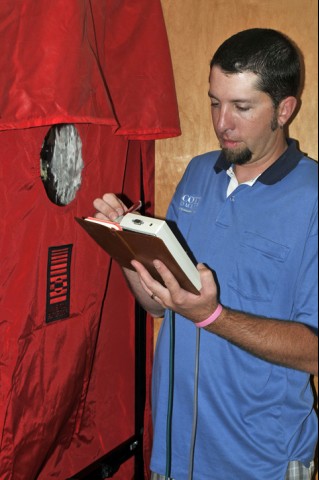DIY - Locate Air Leaks
Detecting Air Leaks
You may already know where some air leakage occurs in your home, such as an under-the-door draft, but you'll need to find the less obvious gaps to properly air seal your home.
For a thorough and accurate measurement of air leakage in your home, hire a qualified technician to conduct a RESNT and BPI Professional Home Energy Assessment, particularly a blower door test. A blower door test, which depressurizes a home, can reveal the location of many leaks. A complete energy assessment will also help determine areas in your home that need more insulation.
Without a blower door test, there are ways to find some air leaks yourself.
Visual Inspection
On the outside of your house, inspect all areas where two different building materials meet, including:
- All exterior corners
- Outdoor water faucets
- Where siding and chimneys meet
- Areas where the foundation and the bottom of exterior brick or siding meet.
- Inside your home, inspect around the following areas for any cracks and gaps that could cause air leaks:
- Electrical outlets
- Switch plates
- Door and window frames
- Electrical and gas service entrances
- Baseboards
- Weather stripping around doors
- Fireplace dampers
- Attic hatches
- Wall- or window-mounted air conditioners.
- Cable TV and phone lines
- Where dryer vents pass through walls
- Vents and fans.
Also look for gaps around pipes and wires, foundation seals, and mail slots. Check to see if the caulking and weather stripping are applied properly, leaving no gaps or cracks, and are in good condition. Check the exterior caulking around doors and windows, and see whether exterior storm doors and primary doors seal tightly.
Inspect windows and doors for air leaks. See if you can rattle them, since movement means possible air leaks. If you can see daylight around a door or window frame, then the door or window leaks. You can usually seal these leaks by caulking or weatherstripping them. Check the storm windows to see if they fit and are not broken.
You may also wish to consider replacing your old windows and doors with newer, high-performance ones. If new factory-made doors or windows are too costly, you can install low-cost plastic sheets over the windows.
Jon Howes
Professionally Certified
Jon Howes
Professionally Certified

BPI Certified Building Analysts
RESNET Certified HERS Rater
RRP - Certified Lead Paint Renovator
Colorado Energy Analysts
Certified Energy Rater
Scott Homes, Ltd., Designers & Builders
Construction Superintendent
 |
 |
 |
